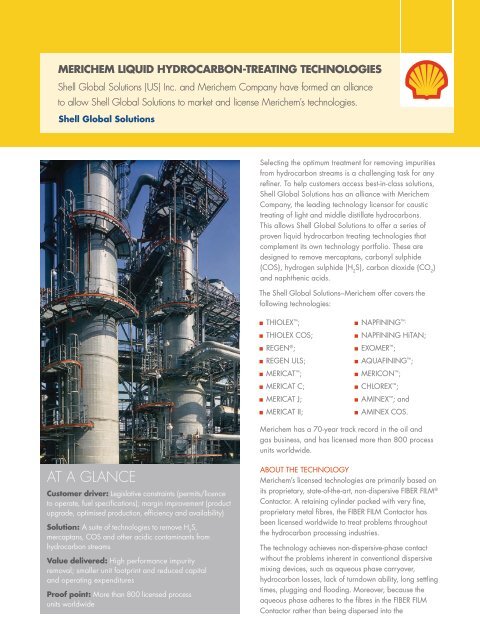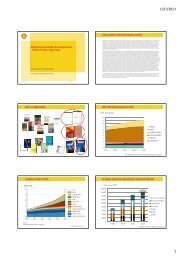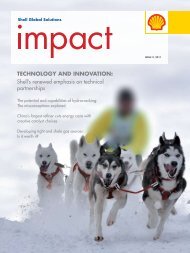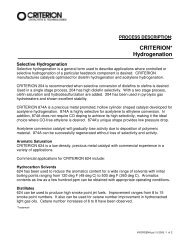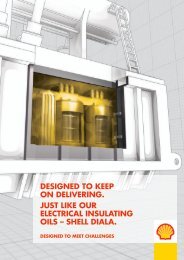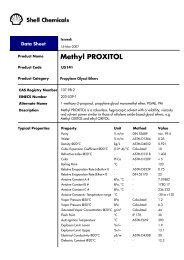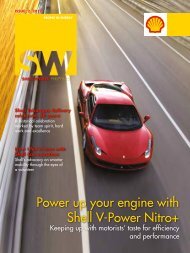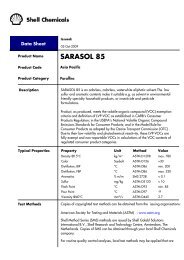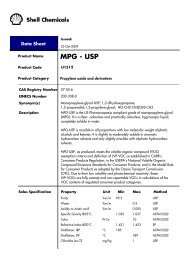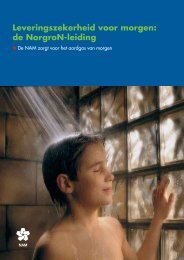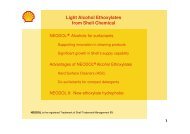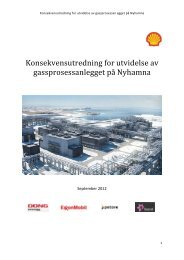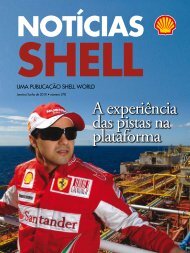Merichem Liquid hydrocarbon-treating Technologies - Shell Global ...
Merichem Liquid hydrocarbon-treating Technologies - Shell Global ...
Merichem Liquid hydrocarbon-treating Technologies - Shell Global ...
You also want an ePaper? Increase the reach of your titles
YUMPU automatically turns print PDFs into web optimized ePapers that Google loves.
<strong>Merichem</strong> <strong>Liquid</strong> Hydrocarbon-Treating <strong>Technologies</strong><br />
<strong>Shell</strong> <strong>Global</strong> Solutions (US) Inc. and <strong>Merichem</strong> Company have formed an alliance<br />
to allow <strong>Shell</strong> <strong>Global</strong> Solutions to market and license <strong>Merichem</strong>’s technologies.<br />
<strong>Shell</strong> <strong>Global</strong> Solutions<br />
Selecting the optimum treatment for removing impurities<br />
from <strong>hydrocarbon</strong> streams is a challenging task for any<br />
refiner. To help customers access best-in-class solutions,<br />
<strong>Shell</strong> <strong>Global</strong> Solutions has an alliance with <strong>Merichem</strong><br />
Company, the leading technology licensor for caustic<br />
<strong>treating</strong> of light and middle distillate <strong>hydrocarbon</strong>s.<br />
This allows <strong>Shell</strong> <strong>Global</strong> Solutions to offer a series of<br />
proven liquid <strong>hydrocarbon</strong> <strong>treating</strong> technologies that<br />
complement its own technology portfolio. These are<br />
designed to remove mercaptans, carbonyl sulphide<br />
(COS), hydrogen sulphide (H 2<br />
S), carbon dioxide (CO 2<br />
)<br />
and naphthenic acids.<br />
The <strong>Shell</strong> <strong>Global</strong> Solutions–<strong>Merichem</strong> offer covers the<br />
following technologies:<br />
n T H I OL E X ;<br />
n THIOLEX COS;<br />
n R E G E N ® ;<br />
n REGEN ULS;<br />
n M E R I C AT ;<br />
n MERICAT C;<br />
n MERICAT J;<br />
n MERICAT II;<br />
n NAPFINING ;<br />
n NAPFINING HiTAN;<br />
n E XO M E R ;<br />
n AQUAFINING ;<br />
n M E R I CON ;<br />
n C H LO R E X ;<br />
n A M IN E X ; and<br />
n AMINEX COS.<br />
<strong>Merichem</strong> has a 70-year track record in the oil and<br />
gas business, and has licensed more than 800 process<br />
units worldwide.<br />
AT A GLANCE<br />
Customer driver: Legislative constraints (permits/licence<br />
to operate, fuel specifications); margin improvement (product<br />
upgrade, optimised production, efficiency and availability)<br />
Solution: A suite of technologies to remove H 2<br />
S,<br />
mercaptans, COS and other acidic contaminants from<br />
<strong>hydrocarbon</strong> streams<br />
Value delivered: High performance impurity<br />
removal; smaller unit footprint and reduced capital<br />
and operating expenditures<br />
Proof point: More than 800 licensed process<br />
units worldwide<br />
About the technology<br />
<strong>Merichem</strong>’s licensed technologies are primarily based on<br />
its proprietary, state-of-the-art, non-dispersive FIBER FILM ®<br />
Contactor. A retaining cylinder packed with very fine,<br />
proprietary metal fibres, the FIBER FILM Contactor has<br />
been licensed worldwide to treat problems throughout<br />
the <strong>hydrocarbon</strong> processing industries.<br />
The technology achieves non-dispersive-phase contact<br />
without the problems inherent in conventional dispersive<br />
mixing devices, such as aqueous phase carryover,<br />
<strong>hydrocarbon</strong> losses, lack of turndown ability, long settling<br />
times, plugging and flooding. Moreover, because the<br />
aqueous phase adheres to the fibres in the FIBER FILM<br />
Contactor rather than being dispersed into the
Untreated<br />
<strong>hydrocarbon</strong><br />
Treated<br />
<strong>hydrocarbon</strong><br />
pRoof poINTs<br />
Fresh caustic or<br />
lean caustic<br />
from REGEN ®<br />
Spent caustic<br />
or rich caustic<br />
to REGEN ®<br />
Figure 1: THIOLEX technology employs the FIBER FILM Contactor as the mass<br />
transfer device and utilises caustic as the <strong>treating</strong> reagent to remove acid gas<br />
and mercaptan compounds from liquid and gas <strong>hydrocarbon</strong> streams.<br />
<strong>hydrocarbon</strong> phase, carryover is virtually eliminated.<br />
Uncontrollable emulsions are also eliminated because<br />
effective phase contact occurs without dispersion.<br />
Process description<br />
THIOLEX: Caustic extraction of acid gas and mercaptan<br />
compounds from liquid and gas <strong>hydrocarbon</strong> streams<br />
(Figure 1). The technology has been licensed for over 220<br />
units since 1980.<br />
THIOLEX COS: Caustic/catalyst extraction of acid gas<br />
and COS compounds from liquid and gas<br />
<strong>hydrocarbon</strong> streams.<br />
REGEN: Regeneration of rich caustic streams to<br />
improve caustic utilisation. Typically, REGEN is used to<br />
regenerate the mercaptide-rich caustic that THIOLEX<br />
purges, returning a lean caustic stream for additional<br />
mercaptan removal. Disulphide oil (DSO) gravity<br />
separation or solvent washing minimises the impact of<br />
DSO back-extraction (Figure 2). It can also be used to<br />
revive rich or spent caustic streams emanating from<br />
refinery <strong>treating</strong> units. REGEN technology was first<br />
licensed in 1980. To date, <strong>Merichem</strong> has granted<br />
operating licences to 151 units worldwide.<br />
Tüpraş<br />
Turkish oil company Tüpraş selected <strong>Merichem</strong><br />
technologies to treat a 22,000 barrel-per-stream-day<br />
<strong>hydrocarbon</strong> stream at its Izmir refinery. NAPFINING,<br />
MERICAT II, and AQUAFINING technologies are<br />
being used to help meet jet fuel specifications.<br />
<strong>Merichem</strong> also licensed its MERICON spent caustic<br />
neutralisation technology to treat up to 1.6 m 3 /h of<br />
spent caustic ahead of the existing wastewater<br />
treatment plant.<br />
Samsung Total Petrochemicals Co. Ltd.<br />
Samsung selected <strong>Merichem</strong> technologies for its<br />
heavy-ends by-product upgrade project.<br />
NAPFINING, MERICAT II and AQUAFINING<br />
technologies treat 15,000 barrels-per-stream-day of<br />
jet fuel in order to meet internationally accepted jet<br />
fuel specifications.<br />
Refineria de Cartagena SA (Reficar)<br />
Reficar selected <strong>Merichem</strong> technologies to treat<br />
<strong>hydrocarbon</strong>s and spent caustic at its refinery in<br />
Cartagena, Colombia. AMINEX, THIOLEX and<br />
REGEN technologies are used to treat coker LPG<br />
and saturated LPG at the facility. In addition,<br />
NAPFINING, MERICAT II, and AQUAFINING<br />
technologies, in conjunction with salt and clay beds,<br />
treat kerosene and jet fuel streams.<br />
<strong>Shell</strong> Eastern Petroleum Pte Ltd<br />
<strong>Shell</strong> selected <strong>Merichem</strong> technologies for a revamp<br />
project at its refinery in Pulau Bukom, Singapore.<br />
<strong>Merichem</strong> will supply its THIOLEX and REGEN<br />
technologies to treat propane/propylene, butane/<br />
butylene and light catalytically cracked gasoline<br />
streams in order to meet product specifications.<br />
REGEN ULS: Regeneration of mercaptide-rich caustic,<br />
which yields a lean caustic with minimal DSO backextraction<br />
into the LPG. Ultra-low sulphur levels can be<br />
achieved in the treated product. Ideal applications are<br />
high-sulphur coker LPG streams and LPG streams, and<br />
LPG products requiring less than 5ppm sulphur. The<br />
technology can often treat LPG pre-fractionation in a<br />
single train, whereas conventional technologies usually<br />
require multiple trains post-fractionation.<br />
MERICAT and MERICAT C: A caustic/catalyst/air mixture<br />
removes hydrogen sulphide and sweetens mercaptan<br />
compounds in gasoline, naphtha, condensate and crude<br />
oil streams (Figure 3). The technology has been licensed<br />
to more than 148 units since 1977.
Source Stream (impurities) Applicable technologies<br />
Crude distillation unit<br />
Overhead offgas (H 2<br />
S, RSH,<br />
COS, CO 2<br />
)<br />
AMINEX, THIOLEX, REGEN, REGEN ULS<br />
Saturated LPG (H 2<br />
S, RSH, COS)<br />
AMINEX, THIOLEX, REGEN, REGEN ULS<br />
LSR/HSR naphtha (H 2<br />
S, RSH)<br />
THIOLEX, REGEN, MERICAT<br />
Jet fuel/kerosene (RCOOH, RSH)<br />
NAPFINING HiTAN, MERICAT II, MERICAT J, AQUAFINING<br />
Diesel (RCOOH)<br />
NAPFINING HiTAN, AQUAFINING<br />
Downstream<br />
applications<br />
Catalytic refomer<br />
Unstabilised reformate<br />
(HCl, NH 4<br />
Cl)<br />
CHLOREX<br />
FCC or RCC<br />
Unsaturated LPG (H 2<br />
S, RSH, COS)<br />
THIOLEX, REGEN, REGEN ULS<br />
Light FCC gasoline (H 2<br />
S, RSH)<br />
THIOLEX, REGEN, MERICAT, EXOMER<br />
Heavy or full range FCC gasoline<br />
(H 2<br />
S, RSH)<br />
MERICAT, MERICAT II, MERICAT J, EXOMER<br />
Coker, visbreaker or<br />
hydrocracker<br />
LPG and naphtha (H 2<br />
S, RSH,<br />
COS)<br />
AMINEX, THIOLEX, REGEN, REGEN ULS, MERICAT<br />
Source Stream (impurities) Applicable technologies<br />
Midstream<br />
applications<br />
NGL fractionation Natural gas (H 2<br />
S, RSH, COS, CO 2<br />
)<br />
Propane (H 2<br />
S, RSH, COS)<br />
Butane (H 2<br />
S, RSH)<br />
Natural gasoline (H 2<br />
S, RSH)<br />
AMINEX, THIOLEX, REGEN, REGEN ULS<br />
AMINEX, THIOLEX, REGEN, REGEN ULS<br />
THIOLEX, REGEN, REGEN ULS<br />
THIOLEX, REGEN, MERICAT II, MERICAT J<br />
Source Stream (impurities) Applicable technologies<br />
Gas production field Natural gas (H 2<br />
S, RSH, COS, CO 2<br />
)<br />
LPG (H 2<br />
S, RSH, COS)<br />
Condensate (H 2<br />
S, RSH)<br />
AMINEX, THIOLEX, REGEN<br />
AMINEX, THIOLEX, REGEN<br />
NAPFINING, THIOLEX, REGEN, MERICAT, MERICAT II<br />
Upstream<br />
applications<br />
Oil production field<br />
Associated gas (HCl, NH 4<br />
, NH 4<br />
Cl)<br />
Light crude oil (H 2<br />
S, CO 2<br />
,<br />
RCOOH, RSH)<br />
AMINEX, THIOLEX, REGEN<br />
NAPFINING, MERICAT<br />
Oil sands heavy oil<br />
upgrader<br />
Fuel gas (H 2<br />
S, RSH, COS, CO 2<br />
)<br />
LPG (H 2<br />
S, RSH, COS)<br />
AMINEX, THIOLEX, REGEN<br />
AMINEX, THIOLEX, REGEN
Air<br />
Offgas<br />
Untreated<br />
<strong>hydrocarbon</strong><br />
Treated<br />
<strong>hydrocarbon</strong><br />
Oxidiser<br />
DSO gravity<br />
separator<br />
Solvent<br />
wash<br />
Fresh<br />
solvent<br />
Air<br />
Catalyst<br />
Rich caustic<br />
from THIOLEX<br />
Catalyst<br />
Coal<br />
Spent<br />
caustic<br />
Fresh<br />
cascaded<br />
caustic<br />
Spent caustic<br />
Lean caustic<br />
to THIOLEX<br />
Fresh<br />
caustic<br />
Solvent/DSO<br />
Sand filter<br />
Figure 2: REGEN technology processes regenerable rich caustic streams<br />
produced in the refinery, allowing it to be recycled thereby significantly<br />
improving caustic utilisation. Typically REGEN is coupled with extractive<br />
THIOLEX technology to regenerate the mercaptide-rich caustic purged<br />
from the THIOLEX system, returning a lean caustic stream for additional<br />
mercaptan removal.<br />
MERICAT J: A special solution mixed with air oxidises<br />
heavy mercaptans in jet fuel and middle distillate streams<br />
without the need for a fixed carbon bed.<br />
MERICAT II: A caustic/catalyst/air mixture removes<br />
hydrogen sulphide and sweetens mercaptan<br />
compounds in jet fuel, kerosene and gasoline and<br />
naphtha streams. MERICAT II has been licensed to over<br />
43 units since 1986.<br />
NAPFINING and NAPFINING HiTAN: Caustic<br />
extraction of naphthenic acid compounds from jet fuel,<br />
kerosene, diesel, condensate and crude oil streams.<br />
NAPFINING technology was first licensed in 1977. Since<br />
then, <strong>Merichem</strong> has granted operating licences to 75 units<br />
worldwide. Unlike electrostatic precipitators, the<br />
technology offers an on-stream factor between routine<br />
turnarounds of 100% and can process high TAN (>0.1<br />
mg KOH/g) feeds.<br />
EXOMER: A proprietary <strong>treating</strong> reagent removes the<br />
recombinant mercaptans that form in selectively hydrotreated<br />
fluidised catalytic cracked gasoline or heavier molecular<br />
weight mercaptans from liquid <strong>hydrocarbon</strong> streams. The<br />
capital expenditure for a grassroots EXOMER unit is<br />
35–50% of the cost of incremental hydro<strong>treating</strong> capacity,<br />
and the operating costs per barrel are approximately<br />
60–70% less when compared with hydro<strong>treating</strong>.<br />
AQUAFINING: Water extraction of soluble organic and<br />
inorganic impurities from liquid and gas <strong>hydrocarbon</strong><br />
streams. AQUAFINING technology was first licensed in<br />
1978 and to date has <strong>Merichem</strong> has granted 90 unit<br />
operating licenses worldwide.<br />
MERICON: On-site solutions for the processing of spent<br />
caustics to reduce their biochemical oxygen demand and<br />
chemical oxygen demand, control odour and adjust acidity.<br />
Figure 3: MERICAT and MERICAT C technologies employ the FIBER FILM<br />
Contactor as the mass transfer device and utilise a caustic/catalyst/air mixture<br />
as the <strong>treating</strong> reagent to remove hydrogen sulphide and sweeten mercaptan<br />
compounds in gasoline, naphtha, condensate and crude oil streams.<br />
The technology produces a neutral brine effluent stream<br />
that can be routed to waste-water <strong>treating</strong> facilities,<br />
evaporation ponds or waterways. MERICON technology<br />
was first licensed in 1988. To date, <strong>Merichem</strong> has granted<br />
operating licences to 27 units worldwide.<br />
CHLOREX: Alkaline water extraction of inorganic chloride<br />
compounds from reformer gas and liquid product streams.<br />
CHLOREX designs produce a more readily handled<br />
effluent stream compared with the waste material<br />
generated by sacrificial solid adsorbent beds. The<br />
technology has been licensed four times since 1991.<br />
AMINEX and AMINEX COS: A special amine removes<br />
acid gas and COS compounds from LPG-type and gas<br />
streams. The technology has been licensed 27 times<br />
since 1998.<br />
HAvE yOu CONsidErEd HOw yOu CAN<br />
n Process feedstocks that contain difficult-to-remove<br />
impurities<br />
n Achieve higher levels of impurity removal?<br />
n Avoid emulsification, carryover and pressure<br />
drop in your mixing vessels?<br />
n Minimise your use of fresh caustic?<br />
All statements regarding <strong>Merichem</strong> Company, its affiliates and their<br />
products are based solely on information provided by <strong>Merichem</strong> Company<br />
and have not been independently verified by <strong>Shell</strong> <strong>Global</strong> Solutions.<br />
For more information, please visit our website at www.shell.com/globalsolutions<br />
<strong>Shell</strong> <strong>Global</strong> Solutions is a network of independent technology companies in the <strong>Shell</strong> Group. In this<br />
brochure, the expression ‘<strong>Shell</strong> <strong>Global</strong> Solutions’ is sometimes used for convenience where reference<br />
is made to these companies in general, or where no useful purpose is served by identifying a<br />
particular company.<br />
The information contained in this material is intended to be general in nature and must not be relied<br />
on as specific advice in connection with any decisions you may make. <strong>Shell</strong> <strong>Global</strong> Solutions is not<br />
liable for any action you may take as a result of you relying on such material or for any loss or<br />
damage suffered by you as a result of you taking this action. Furthermore, these materials do not in<br />
any way constitute an offer to provide specific services. Some services may not be available in certain<br />
countries or political subdivisions thereof.<br />
Copyright © 2010 <strong>Shell</strong> <strong>Global</strong> Solutions International BV. All rights reserved. No part of this<br />
publication may be reproduced or transmitted in any form or by any means, electronic or mechanical<br />
including by photocopy, recording or information storage and retrieval system, without permission in<br />
writing from <strong>Shell</strong> <strong>Global</strong> Solutions International BV.<br />
GS33311110 En(A)


